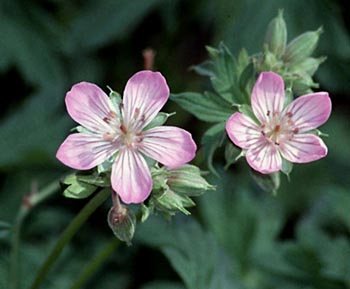Richardson's Gernanium

Common Name(s):
Richardsons geranium
Scientific Name:
Geranium richardsonii Fisch. & Trautv.
Scientific Name Synonyms:
None Known
Symbol:
GERI
Description:
Life Span: Perennial
Origin: Native
Season: Cool
Growth Characteristics: A flowering forb, growing 4 to 36 inches tall, with 1 to a few stems. Stems are stout, forked, and hairy. Flowers May to August, fruits mature August to September. Reproduces by seed.
Flowers/Inflorescence: Flowers in pairs. Flowers are usually white to pink colored with purple veins and five petals. The flower stalks are always hairy.
Fruits/Seeds: Each seed is tipped with an elongated tail, which coils spirally at maturity, assisting the pointed seed in penetrating the soil.
Leaves: Palmately lobed, upper leaves smaller in size. Petioles of basal and lower leaves are hairy, but not sticky. Leaves give off a distinctive odor when crushed.
Ecological Adaptions:
Richardson's geranium occurs in a variety of habitats including woodlands, forest openings, grasslands, meadows, and riparian areas such as stream terraces, alluvial benches, wet valley bottoms, and stream and lake margins. It is most commonly found in moist areas. It is moderately tolerant of drought.
Soils: Richardson's geranium grows best on moist to semiwet soils with good drainage. It grows best on loam, sandy loam, and clayey loam soils derived from shale and limestone, but occurs on gravelly substrates as well.
Associated Species: Sagebrush, rabbitbrush, tall larkspur, lupine, willows, sedges, brome grasses.
Uses and Management:
Richardson's geranium is a valuable forage species for livestock, deer and elk. It is rated good for sheep and fair for cattle and horses. It decreases in palatability after reaching maturity.
Cheyenne Indians pulverized leaves into a powder and snuffed it into their noses to control nosebleeds. Roots were also powdered and made into a drink.

